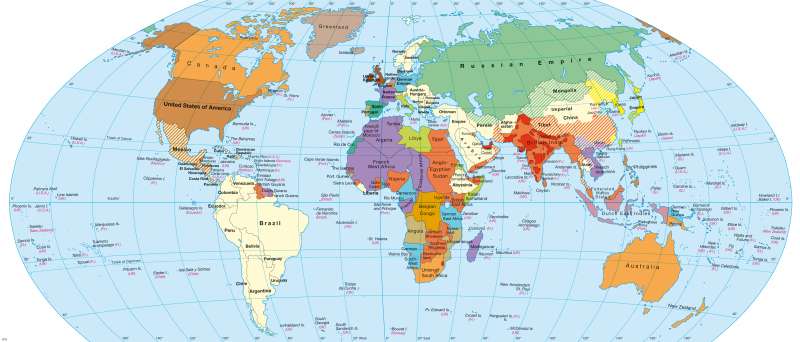The world 1914
The world - The age of imperialism
978-3-14-100790-9 | Page 184 | Ill. 1

Information
The map shows the extent of the imperialistic sphere of influence and other colonial powers on the eve of World War II.Forms of Domination in The British Empire
The British Empire is characterised by a mosaic of very different forms of government.
The Crown Colonies were directly subordinate to the Colonial Office in London and were ruled by a governor. These were essentially small, easily controlled territories in the Caribbean, Hong Kong and Ceylon (now Sri Lanka) in Asia, Sierra Leone and Ghana in Africa and around the Falkland Islands and Gibraltar. Also, the protectorates were directly governed but not to the same extent such as in Kenya.
Colonially dominated areas were ruled by the sovereign functions of a colonial administration and headed by the respective governor. The previous local leaders and the colony's political structures were mostly replaced in their entirety.
The rule of the ordering form of "indirect rule" was practiced. For example, the arrangement in India mainly meant it was under the sovereignty of colonial domination in small, fragmented, local government structures by local authorities (cheiftains, elders or otherwise). Their capabilities and influence were heavily regulated and restricted to domestic politics. In British India, there were over 500 of these small states. Often, they were located in economically unattractive areas (mountain areas), semi-deserts and inland areas. In some areas, such as Zanzibar, the domination was exercised by a small group of British advisers who determined the policy of a puppet government as a facade which it essentially maintained.
Dominions were State-formation, which began in 1839 (with Canada) through the gradual transformation from colonies. In them, the layer of the white settlers exercised the power, yet they were still closely linked with the motherland. Other examples are New Zealand, Australia and the Republic of South Africa. The dominions model was also introduced in parts of Africa after World War I.
India occupied a special position though, as large parts of the country had been under the control of non-British East India Company for some time. In 1858, the then Viceroy of India used his wide-ranging powers and, in 1876, elevated Queen Victoria to Empress of India. Hence, she was in a personal union as English and Indian official head of state.
Among the relatively annexed states of the British Empire, areas of influence were in China, Thailand and West Asia, where with gunboat diplomacy and if necessary, war (Opium Wars against China), had forced the opening up of markets for the British economy. The location and extent of involvement were largely determined by economic interests.
Special rights were enshrined in contractual arrangements. Consulates and consultants could easily influence local governments. A direct exercise of power over the colonial administration or a governor did not really exist.
M. Felsch; Ü: C. Fleming




